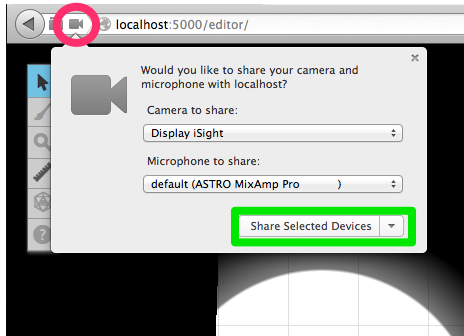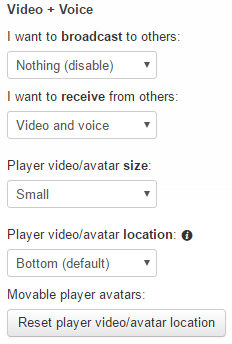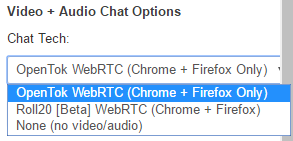Difference between revisions of "Video and Voice Chat"
From Roll20 Wiki
Kristin C. (Talk | contribs) (→Swapping Between OpenTok WebRTC or Roll20 WebRTC) |
Kristin C. (Talk | contribs) |
||
| Line 48: | Line 48: | ||
<div style="clear: both"></div> | <div style="clear: both"></div> | ||
| + | ==Roll20 WebRTC Features== | ||
| + | ===Relocating Player Avatars Around the Tabletop=== | ||
| + | One of the unique features of Roll20 WebRTC is the ability to move the player avatars to wherever you want on the screen. This can be very helpful when you have a specific broadcast overlay for streaming. This feature is always enabled for the Game Master, but it can be either disabled or enabled for the players to re-order the avatars as they see fit. | ||
| + | |||
| + | Movable video windows. I've always wanted to use video chat, but all the action always happens at the bottom left corner of my map, whatever will I do? You can just drag your videos wherever you want them! | ||
| + | |||
| + | ===Whispering=== | ||
| + | Whispering. You're the GM and your player secretly just got charmed, but you don't have the time to have a long text conversation through whispering in chat. Have no fear! You can click the whisper button on your player's video and have a quick side-conversation with them and get back to watching your newly acquired puppet turn on his allies! HA HA HA (this is currently only available for GMs, but it will eventually be able to be turned on for all players) | ||
| + | |||
| + | ===Video/Voice Bandwith Options=== | ||
| + | Voice/Video Bandwidth Options. Do you and your players live inside of your ISP and have all of the bandwidth you could ever want?? (lucky you) Awesome! Watch some super smooth video of all your friends do their thing. Does one of your players live out in the forest where the only internet they have is delivered by carrier pidgin? No problem! Lower your video settings and you can still get to see their smiling face, though slightly less smoothly than before; internet is heavy and pigeon is tired. | ||
| + | |||
| + | ===Push to Talk Functionality=== | ||
| + | Hotkey Control. Does your roommate like to tell embarrassing stories while you're on video, do you have a fan pointed directly at your microphone, are you allergic to air and constantly sneezing into your player's ears? Do we have the solution for you! Once you've turned on "Use advanced keyboard shortcuts" you can use the tilde ( ` ) key to mute/unmute yourself at the push of a button! (please be aware that the keyboard shortcuts will only work when you have the Roll20 Editor tab focused, so it won't work if you have another tab or another program like a PDF selected when you push the button) | ||
| + | |||
| + | ===Video Only Broadcast=== | ||
| + | Video Only. For all of those RPGs simulating the Silent Film Era, we've got you covered! It's like Video Chat, without the Chat part. So Video thing. | ||
==OpenTok WebRTC Features== | ==OpenTok WebRTC Features== | ||
=== Managing Volume === | === Managing Volume === | ||
Revision as of 00:07, 23 October 2016
Roll20 utilizes two built-in WebRTC video and voice chat features that allows you to communicate with other players. One is powered by Tokbox's OpenTok 2.0 and the other is an in-house version built by Roll20. As of October 2016, the Roll20 WebRTC option is the default video/voice chat tech for newly created campaigns. WebRTC is high-definition and runs natively in your browser without the need for any additional plugins. It's also adaptive so it works well with low-bandwidth connections.
Once at least two people log into a game using either WebRTC options, you should see a dialog box along the top of your screen that asks you to give permission for Roll20 to use your camera/microphone.
| Note: If you aren't having much luck with the built-in video/voice chat, you might also try running your game in a Google+ Hangout, which offers an alternative way of having video/voice chat in your game. Read more... |
Contents[hide] |
Enabling and Disabling WebRTC Video & Voice Chat
Managing Browser Permissions
In Google Chrome:
A dialog box will appear along the very top of your browser screen. Click "Allow." (You may only have to do this the first time you use WebRTC).
Note that you can click the little camera icon located in the far-right of your address bar to change the settings of what camera/microphone is being used.
In Mozilla Firefox:
A dialog box will appear, click on "Share Selected Devices" to allow Roll20 to start video chat (highlighted in green below). If for some reason a dialog box does not appear, or if you wish to change your settings after the game has started, click on the Camera icon (highlighted in pink below) to change your settings.
Roll20 Video/Voice Settings
Go to the My Settings tab (the ![]() icon) on the Sidebar (top-right side of the screen). Scroll down to find the Video + Voice heading. There will be several drop-down menus here. They are:
icon) on the Sidebar (top-right side of the screen). Scroll down to find the Video + Voice heading. There will be several drop-down menus here. They are:
- I want to Broadcast to others: This controls whether or not you will broadcast Video and Voice, Video only(Roll20 WebRTC feature), Voice only, or Nothing(disabled) to other players in the game.
- I want to Receive from others: This controls whether or not you will receive Video and Voice, Video only(Roll20 WebRTC feature), Voice only, or Nothing(disabled) from other players, if they are broadcasting at all.
- Player Video/Player Avatar Size: This controls the size of the player avatars that are shown on the Tabletop. There are four size options available: Large (200px x 200px), Regular (150px x 150px), Small (100px x 100px) and Names Only. If the last option is selected, the portrait image is hidden entirely and all that remains is the user's name plate. Note that if you choose Names Only, you will still broadcast video and/or voice if that setting is enabled. You need to set the Broadcast To Others setting to broadcast voice-only, or nothing at all.
The following feature options ONLY appear when Roll20 WebRTC is currently enabled:
- Player Video/Avatar Location: This controls where your player avatars are positioned on the Tabletop when using Roll20 WebRTC. You have the option of setting them at the bottom or at the top of the tabletop. At default, the avatars are aligned to the bottom.
- Moveable Player Avatars: One of the features of Roll20WebRTC is the ability to move the Player Avatars to wherever you want on the Tabletop. Underneath this setting is a single reset button available only when using Roll20 WebRTC. Clicking this will snap the player avatars back to the location you originally designated in previous setting.
Swapping Between OpenTok WebRTC or Roll20 WebRTC
Further down on the My Settings tab, past the Video + Voice heading is the Video + Audio Chat Options Options heading.
Chat Tech: This drop down menu allows you to switch between Roll20 WebRTC, OpenTok WebRTC, or None for your video/voice chat options. Upon choosing a different Video selection than what was selected before (this includes setting it to or from None), your and all other players currently in the game will have their browser tab refreshed. This is necessary to change up the chat tech.
Roll20 WebRTC Features
Relocating Player Avatars Around the Tabletop
One of the unique features of Roll20 WebRTC is the ability to move the player avatars to wherever you want on the screen. This can be very helpful when you have a specific broadcast overlay for streaming. This feature is always enabled for the Game Master, but it can be either disabled or enabled for the players to re-order the avatars as they see fit.
Movable video windows. I've always wanted to use video chat, but all the action always happens at the bottom left corner of my map, whatever will I do? You can just drag your videos wherever you want them!
Whispering
Whispering. You're the GM and your player secretly just got charmed, but you don't have the time to have a long text conversation through whispering in chat. Have no fear! You can click the whisper button on your player's video and have a quick side-conversation with them and get back to watching your newly acquired puppet turn on his allies! HA HA HA (this is currently only available for GMs, but it will eventually be able to be turned on for all players)
Video/Voice Bandwith Options
Voice/Video Bandwidth Options. Do you and your players live inside of your ISP and have all of the bandwidth you could ever want?? (lucky you) Awesome! Watch some super smooth video of all your friends do their thing. Does one of your players live out in the forest where the only internet they have is delivered by carrier pidgin? No problem! Lower your video settings and you can still get to see their smiling face, though slightly less smoothly than before; internet is heavy and pigeon is tired.
Push to Talk Functionality
Hotkey Control. Does your roommate like to tell embarrassing stories while you're on video, do you have a fan pointed directly at your microphone, are you allergic to air and constantly sneezing into your player's ears? Do we have the solution for you! Once you've turned on "Use advanced keyboard shortcuts" you can use the tilde ( ` ) key to mute/unmute yourself at the push of a button! (please be aware that the keyboard shortcuts will only work when you have the Roll20 Editor tab focused, so it won't work if you have another tab or another program like a PDF selected when you push the button)
Video Only Broadcast
Video Only. For all of those RPGs simulating the Silent Film Era, we've got you covered! It's like Video Chat, without the Chat part. So Video thing.
OpenTok WebRTC Features
Managing Volume
While video/voice is enabled in Roll20, hover your mouse on the bottom right corner of a player's portrait in the Player Zone. This action will pop up a volume slider that you can use to fine tune a player's mic volume to be heard properly. It's important to note that a slider exists on your own portrait and tuning your personal mic volume affects how other players in Roll20 hear you.
Switching Devices
To switch between multiple microphone and webcam devices, once again hover your mouse on the bottom right corner of your avatar in the Player Zone. Next to the volume slider that pops up is a wrench button. Clicking on this button brings up a new window where you can specify which devices you wish to use for chat.
Push-to-talk
Push-to-talk is a concept where you hold down a key to talk, and let go when you're not talking. It controls the on/off of your microphone, making it act like a "walkie-talkie".
Why you want everyone to have this:
- Lets everyone use the regular roll20 interface without installing and setting up a complex extra program like Skype, Ventrilo, Teamspeak, Mumble or Discord.
- Some of these types of program require hosting services, which adds even more complexity.
- Most of these types of program are complex to set up, and would require lots of audio device fiddling and volume customization per-player.
- Stops the noise from that one player who types really loud, eats chips with their headset on, or has screaming kids in the background. You know the one.
However, this feature does not exist in roll20's voice chat.
Options are:
- Muting ones self when not talking.
- But this is quite a lot of effort in conversation.
- Manually using the mic's mute feature.
- Some microphones have a button for this, which is better.
- Using a program which controls your microphone mute feature.
- This is by far the best solution.
One recommendation is http://www.pushtotalk.nu/
- Tested and works with Windows 10 64bit.
- Free, a tiny download, no installation required, trivial to configure.
- One recommendation is to configure its hotkeys as ` (backtick) and right-control. It turns out that right-control will permanently un-mute until backtick is pressed, which is technically a bug but really useful.
Even though it's additional work, ensuring that game policy has all players doing this very simple step will vastly improve everyone's playing experience. Please consider it for your game.
If anyone has another solution or program, please take a moment to post it here.












